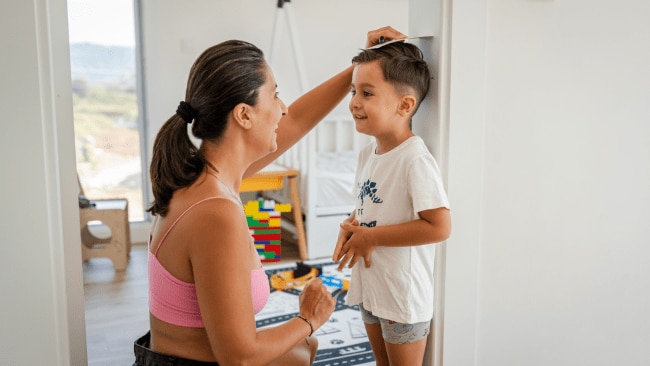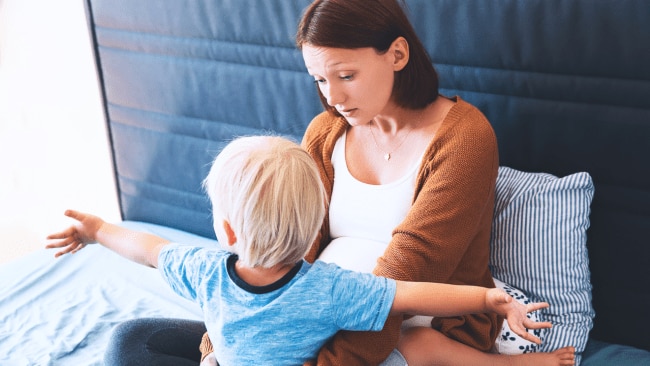I'm a GP and this is what parents don't realise about kids' growth spurts
It's the phase where you're constantly questioning: "Didn't I just buy these pants last week?" But there are other symptoms to consider.

Lifestyle
Don't miss out on the headlines from Lifestyle. Followed categories will be added to My News.
Ah, the joys of parenting. One minute you're marvelling at your child's adorable little feet, and the next, you're wondering how they outgrew their shoes overnight.
Welcome to the world of growth spurts—a mysterious phase where kids seem to grow faster than the grocery bill.
It's the phase where you're constantly questioning: "Didn't I just buy these pants last week?" Yes, you did. But your child is basically a human slinky right now. Growth spurts are as unpredictable as a toddler’s taste in dinner—but they’re a totally normal (if not exhausting) part of raising kids.
And once you know what to expect, they’re a lot less scary and a lot more fascinating.
Want to join the family? Sign up to our Kidspot newsletter for more stories like this.

What exactly is a growth spurt?
A growth spurt is a period of rapid physical growth driven by a surge of hormones—mainly growth hormone, thyroid hormones, and, during puberty, the sex hormones estrogen and testosterone.
Growth spurts follow a general timeline, though every child’s path is unique:
Infancy: Most babies double their birth weight by 4–6 months and triple it by their first birthday.
Early childhood (2–5 years): Growth slows but stays steady—roughly 6–8 cm per year.
Middle childhood (6–10 years): Growth can appear to “pause” but often occurs in short spurts.
Puberty: Where the real action happens. Girls typically have a major growth spurt between ages 10–12, often starting just before they first get their period. Boys usually start later, around 12–14, and tend to grow taller overall, often well into their late teens. During this peak growth velocity in puberty, some kids can grow up to 10 cm in a single year! So yes, that sudden high-waist pants look is scientifically justified.
RELATED: Parents make period board for teen girls
The appetite of a small dinosaur
If your child starts eating like they've been stranded on a desert island, it's probably a growth spurt. Their body needs extra calories, protein, and nutrients to build muscle, bone, and organ tissue.
You might notice cravings, especially for carb-heavy or protein-rich foods. That’s normal—it’s fuel for the stretch that’s ahead.
Rest assured, this is all temporary. But do keep healthy options in sight—what they eat matters just as much as how much they eat.
Sleep: Their new best friend
Kids grow in their sleep—literally. The body releases the most growth hormone during deep sleep, especially early in the night. So if your usually early riser is sleeping in, let them snooze—they’re busy adding centimetres.
Teens, in particular, may need 8–10 hours of sleep a night (good luck with that), and lack of it can actually slow growth or amplify irritability. So yes, “growing tired” is very real.
The clumsy phase
As kids grow, their limbs often lengthen faster than their coordination can keep up. This can result in some impressively ungraceful moments: bumping into furniture, tripping over their own feet, or suddenly “forgetting” how to catch a ball.
Don’t worry—this awkwardness usually settles as their brain and body recalibrate.
Mood swings and emotional rollercoasters
Hormonal changes during growth spurts, especially in puberty, can lead to mood swings, irritability, and general emotional volatility. One moment they're laughing at cat videos, the next they’re weeping because the toast is cut diagonally.
Remember: a little patience, a steady routine, and some protein in their belly works wonders.

RELATED: ‘Please stop commenting on my son’s weight’
Growing pains: Not just a myth
Yes, “growing pains” are real—and they’re surprisingly common. They affect up to 40% of children aged 3–12 years. But they’re not caused by bones stretching.
They’re likely due to muscle fatigue, ligament stretching, or simply the wear and tear of active little bodies adapting to rapid growth.
Key facts about growing pains:
- Usually felt in both legs (calves, thighs, behind the knees).
- Most common at night, sometimes waking children from sleep.
- No swelling, redness, or fever.
- Relieved by gentle massage, warm compresses, and stretching.
If the pain is persistent, localised, or affects mobility, see your GP to rule out anything more serious.
Girls and pre-pubertal weight gain
Before their major growth spurt, girls commonly gain weight—particularly around the hips and thighs. This can be unsettling for parents used to leaner frames, but it’s both normal and necessary.
This extra fat is partly regulated by estrogen and helps support the coming hormonal and reproductive development. It’s not a sign of poor health—it’s a sign of preparation.
Importantly, this is not the time for dieting. The focus should be on balanced nutrition, body confidence, and support, not restriction or criticism.
When should you worry?
While most signs of growth are normal, certain red flags should prompt a check-in with your GP:
- Persistent, severe pain (especially if localised)
- Swelling, redness, or joint warmth
- Limping or mobility issues
- Significant fatigue, weight loss, or appetite changes
- Delayed or very early signs of puberty
Early intervention can help rule out hormonal imbalances or underlying conditions like juvenile arthritis or growth disorders.
What parents need to remember during the spurt months
Growth spurts are one of the most visible reminders that your child is changing - and fast. They’re exciting, weird, and sometimes a bit exhausting (mostly for the shoe budget). But knowing what to expect can help you respond with confidence instead of concern.
So next time your child devours half the fridge, sleeps till noon, and wakes up complaining their legs are “too long” for the bed, congratulate yourself. You’re witnessing biology in action. Stretchy, hungry, slightly moody biology.
In the end, it’s all part of the journey of growing up. You don’t need to measure them every week, panic over a few extra kilos, or stress when they trip over the dog. Just be there with a warm hug, a steady routine, and maybe a new pair of socks—because they’ll outgrow those too.
More Coverage
Originally published as I'm a GP and this is what parents don't realise about kids' growth spurts









